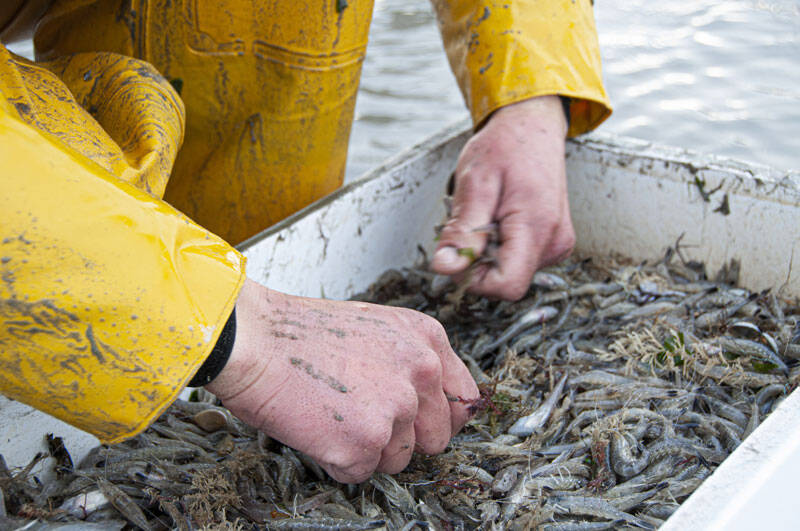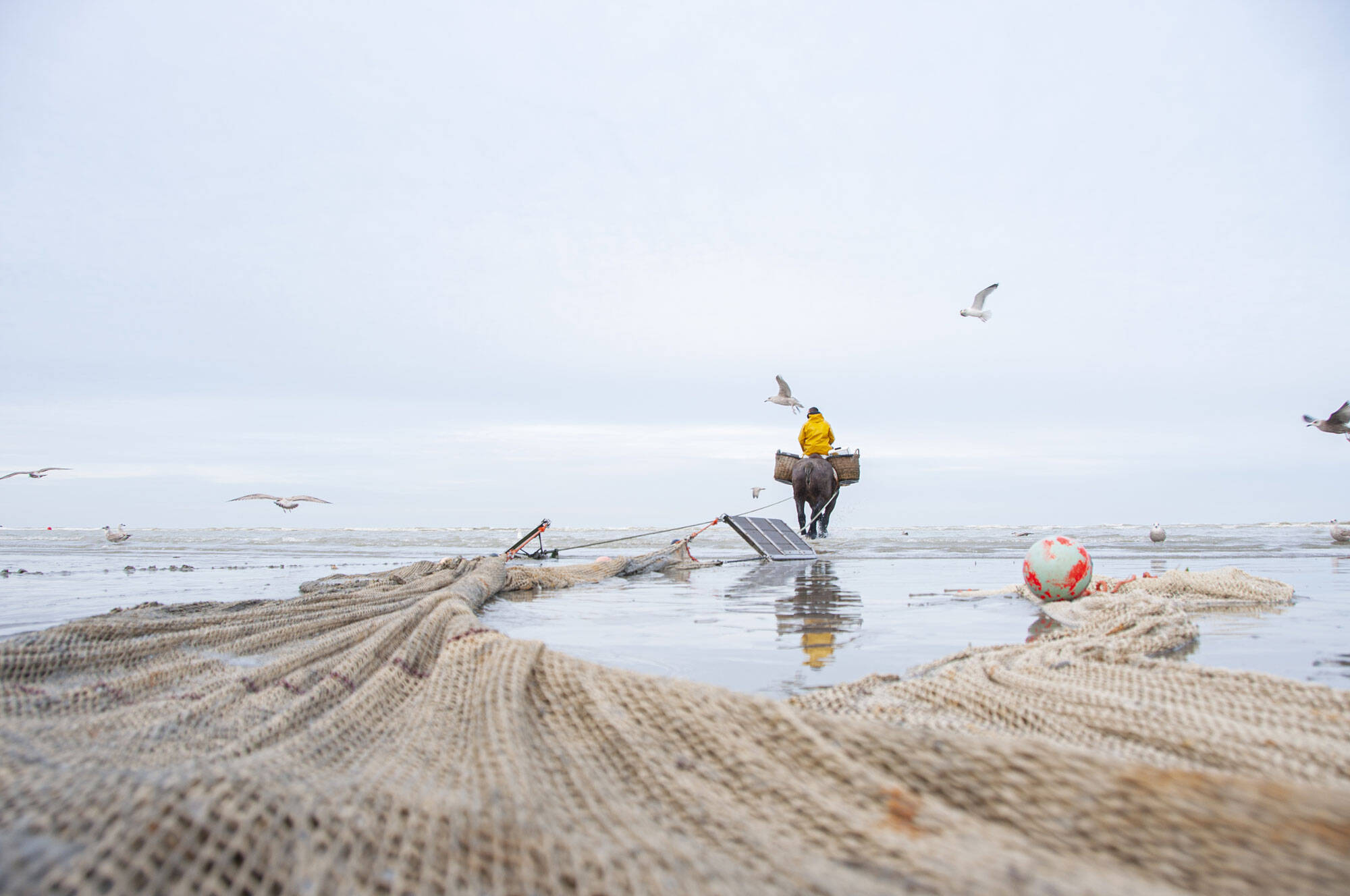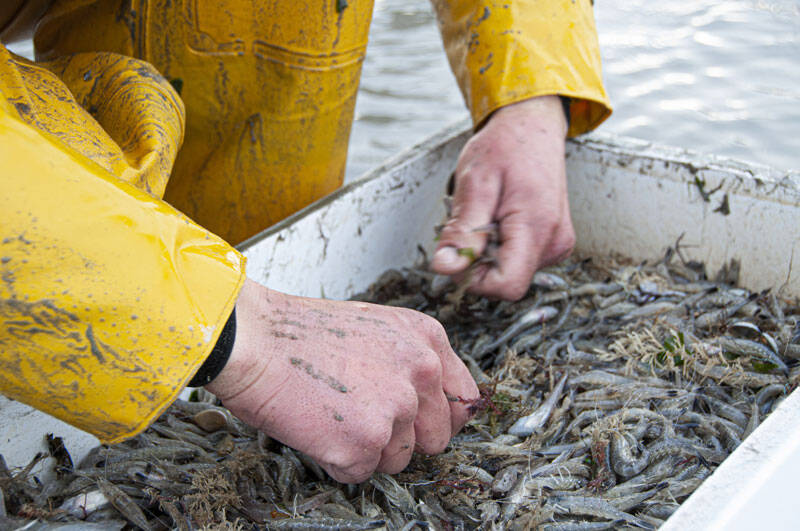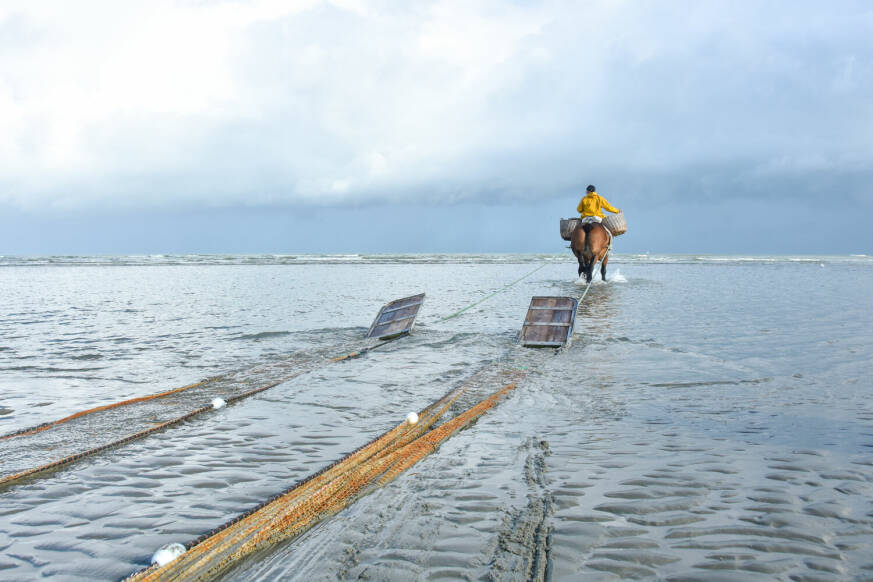How do you become a horse fisherman?
You don't just become a horse fisherman. There is a committee that recognizes new craftsmen. To become one, aspiring horse fishermen must first follow a two-year training course and pass a theoretical and practical exam. A recognized horse fisherman must also be in possession of his own horse and officially recognized equipment. ‘The decision to become a horse shrimp fisherman is a big responsibility. Because you must work with trained animals in a public place, where many people and children reside. It is recommended to carry out increased checks on the practitioners of the craft', as stated in the regulations for the appointment of a municipally recognized shrimp fisherman on horseback in Oostduinkerke.
© SFHLGN

Local family tradition
Fishing is done at low tide, when the current is less strong than at high tide, making it easier for the horses to move through the water. The activity takes place from two hours before low tide to two hours after. Every half hour the fishermen and women lay their nets on the beach and sieve their catch. For the most part they fish shrimp. In the coast off Oostduinkerke mainly gray shrimp, the crangon crangon, can be found. A fisherman catches an average of about five kilos of shrimp at a time. The shrimps caught are for personal consumption only. A recognized horse fisherman is therefore obliged to have a spot in the house – a stove, according to the regulations – where the shrimp can be prepared. The shrimp are cooked in fresh water, after which they are eaten by the horse fisherman and family and friends. They’re not permitted to trade their catch commercially.
The tradition of horse fishing goes back more than 500 years. On the beaches of Belgium, France, England and the Netherlands, farmers and their animals went into the sea to earn an extra penny with the seafood they catched. In 2021 Oostduinkerke in Belgium is the only place in the world where horseback fishing is still practiced. In Oostduinkerke, sixteen horse fishermen are still active; fourteen men and two women. It’s a craft that’s passed from generation to generation.
Maaike de Reuver Nina Slagmolen Xiao Er Kong
Local, artisanal and in harmony with nature; it sounds like the food producer of the future that is taking the limits of our planet in account. But the paardenvissers (horse fishermen) in Oostduinkerke in Belgium, have been working according to this ideology for centuries. Several times a week, men and women on horses go through the sea to fish for shrimp. The craft has been listed by UNESCO as an Intangible Cultural Heritage of Humanity.
the NATURAL BEAUTY of the age-old profession of horse fisherman along the Belgian coast
Craft heritage
video
11 min
© SFHLGN
© Sofhie Legein - Lokaal Bestuur Koksijde



© SFHLGN
© Sofhie Legein - Lokaal Bestuur Koksijde
How do you become a horse fisherman?
You don't just become a horse fisherman. There is a committee that recognizes new craftsmen. To become one, aspiring horse fishermen must first follow a two-year training course and pass a theoretical and practical exam. A recognized horse fisherman must also be in possession of his own horse and officially recognized equipment. ‘The decision to become a horse shrimp fisherman is a big responsibility. Because you must work with trained animals in a public place, where many people and children reside. It is recommended to carry out increased checks on the practitioners of the craft', as stated in the regulations for the appointment of a municipally recognized shrimp fisherman on horseback in Oostduinkerke.
Local family tradition
Fishing is done at low tide, when the current is less strong than at high tide, making it easier for the horses to move through the water. The activity takes place from two hours before low tide to two hours after. Every half hour the fishermen and women lay their nets on the beach and sieve their catch. For the most part they fish shrimp. In the coast off Oostduinkerke mainly gray shrimp, the crangon crangon, can be found. A fisherman catches an average of about five kilos of shrimp at a time. The shrimps caught are for personal consumption only. A recognized horse fisherman is therefore obliged to have a spot in the house – a stove, according to the regulations – where the shrimp can be prepared. The shrimp are cooked in fresh water, after which they are eaten by the horse fisherman and family and friends. They’re not permitted to trade their catch commercially.
Local family tradition
Fishing is done at low tide, when the current is less strong than at high tide, making it easier for the horses to move through the water. The activity takes place from two hours before low tide to two hours after. Every half hour the fishermen and women lay their nets on the beach and sieve their catch. For the most part they fish shrimp. In the coast off Oostduinkerke mainly gray shrimp, the crangon crangon, can be found. A fisherman catches an average of about five kilos of shrimp at a time. The shrimps caught are for personal consumption only. A recognized horse fisherman is therefore obliged to have a spot in the house – a stove, according to the regulations – where the shrimp can be prepared. The shrimp are cooked in fresh water, after which they are eaten by the horse fisherman and family and friends. They’re not permitted to trade their catch commercially.
© SFHLGN

The tradition of horse fishing goes back more than 500 years. On the beaches of Belgium, France, England and the Netherlands, farmers and their animals went into the sea to earn an extra penny with the seafood they catched. In 2021 Oostduinkerke in Belgium is the only place in the world where horseback fishing is still practiced. In Oostduinkerke, sixteen horse fishermen are still active; fourteen men and two women. It’s a craft that’s passed from generation to generation.
Maaike de Reuver Nina Slagmolen Xiao Er Kong
Local, artisanal and in harmony with nature; it sounds like the food producer of the future that is taking the limits of our planet in account. But the paardenvissers (horse fishermen) in Oostduinkerke in Belgium, have been working according to this ideology for centuries. Several times a week, men and women on horses go through the sea to fish for shrimp. The craft has been listed by UNESCO as an Intangible Cultural Heritage of Humanity.
the NATURAL BEAUTY of the age-old profession of horse fisherman along the Belgian coast
Craft heritage

11 min












